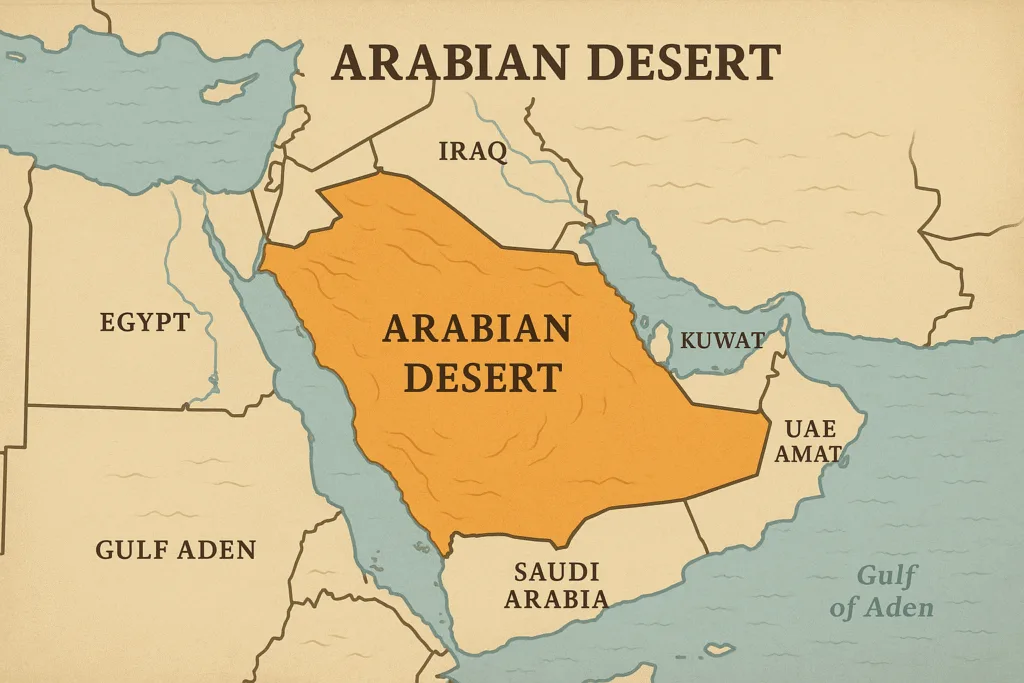Location & Continent
Continent: Asia
Countries: China (Xinjiang Uyghur Autonomous Region)
Coordinates: 40°N, 90°E
Lop Desert – Map & Street View
Physical Features
Area: ~100,000 km² (part of the greater Tarim Basin desert system)
Length: ~500 km (east–west)
Width: ~200–300 km (north–south)
Elevation: Mostly 780–1,000 m above sea level; lowest point near the dried Lop Nur depression
Climate & Precipitation
Temperature: Summer highs can reach 45–50 °C; winter lows drop to −25 °C
Precipitation: Less than 30 mm annually, making it one of the driest regions in Central Asia; most rain falls in summer storms
Ecological Features
Ecozone: Palearctic (cold desert and semi-arid steppe)
Biome: Temperate desert and saline playa environment
Ecoregions: Taklamakan Desert Basin, Eastern Tarim Depression, Lop Nur Basin
Flora & Fauna
Flora: Sparse halophytic vegetation (salt-tolerant plants), such as tamarisk (Tamarix), nitre bush (Nitraria), reeds near former river deltas, and occasional saxaul shrubs
Fauna: Wild Bactrian camels, goitered gazelles, onagers (wild asses), corsac foxes, jerboas, sand lizards, and migratory birds near seasonal lakes
Geology & Notable Features
Geology: Endorheic basin formed by the terminal point of the Tarim River; composed of ancient lake beds, salt crusts, sand dunes, and clay flats
Notable Features: Lop Nur (“the wandering lake”)—once a shifting salt lake, now mostly dry; Loulan ancient city ruins (a key Silk Road archaeological site); the Kumtagh Desert merging from the west; Lop Nur nuclear test site (historical significance)
Introduction
The Lop Desert, also known as the Lop Nur Desert, is a vast expanse that holds a significant place in the geography of China. This desert is not only defined by its harsh conditions but also by its rich history and ecological diversity. In this article, we will explore various facets of the Lop Desert, from its geographical characteristics to its unique climatic conditions.
Geography
The Lop Desert is situated in the Xinjiang Uygur Autonomous Region of China. Covering an area of approximately 250,000 square kilometers, it is bordered by the Taklamakan Desert to the west and the Gobi Desert to the north. The region is characterized by:
- Altitude: The desert is located at an average altitude of 800 meters.
- Topography: Predominantly flat with occasional sand dunes and rocky outcrops.
- Hydrology: The Lop Nor lake, now dried, was once a significant water body that influenced the region’s ecosystem.
Climate
The Lop Desert experiences an extreme climate characterized by:
- Temperature Variations: Summers can soar above 45°C, while winters can plunge below -20°C.
- Precipitation: Average annual rainfall is a mere 30 mm, making it one of the driest places on Earth.
- Wind Patterns: Strong winds, particularly from the north and northwest, can create dramatic sandstorms.
Biodiversity
Despite its harsh conditions, the Lop Desert is home to a surprising array of life forms. The biodiversity includes:
- Flora: Salt-tolerant plants such as halophytes and desert shrubs.
- Fauna: Species like the desert fox and various reptiles have adapted to survive here.
Historical Significance
The Lop Desert has been a critical location in the history of the Silk Road. It served as both a barrier and a gateway for traders moving between East and West. Archaeological findings in the region reveal:
- Ancient Settlements: Remnants of prehistoric human settlements and trade routes.
- Artifacts: Items such as pottery and textiles that illustrate the cultural exchange that occurred here.
Data Comparison Table: Lop Desert vs. Other Major Deserts
| Desert Name | Location | Area (sq km) | Average Rainfall (mm) | Temperature Range (°C) |
|---|---|---|---|---|
| Lop Desert | China | 250,000 | 30 | -20 to 45 |
| Taklamakan | China | 337,000 | 30 | -20 to 50 |
| Gobi Desert | Mongolia/China | 1,295,000 | 194 | -40 to 40 |
| Sahara | Africa | 9,200,000 | 3-25 | -12 to 50 |
Visiting the Lop Desert
Traveling to the Lop Desert presents opportunities for adventure seekers. The main attractions include:
- Photography: The stark contrasts of sand and sky provide breathtaking shots.
- Exploration: Adventurous treks can lead to unique landscapes, including ancient ruins.
- Cultural Experiences: Interaction with local Uyghur communities fosters a greater understanding of the region’s heritage.
Conclusion
In conclusion, the Lop Desert is a fascinating phenomenon characterized by its extreme climate, diverse life forms, and historical richness. While it embodies challenges, it also offers immense beauty and cultural significance. A visit to this unique desert is not just an exploration of nature but a journey into the heart of an ancient civilization that continues to thrive against all odds.
References
Chinese Academy of Sciences — “Environmental Changes and Desertification in the Lop Nur Basin”
National Natural Science Foundation of China — “Geomorphological Evolution of the Lop Desert and the Tarim Basin”
UNESCO — “Silk Roads: the Routes Network of Chang’an–Tianshan Corridor (includes Lop Nur and Loulan sites)”
University Sources
Lanzhou University — “Late Quaternary environmental evolution of the Lop Nur region, eastern Tarim Basin”
Chinese Academy of Sciences / Springer — “Lop Nur Lake evolution and environmental records in arid northwest China”


